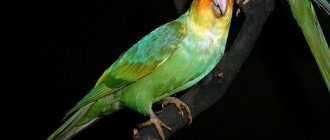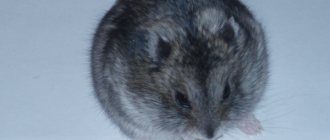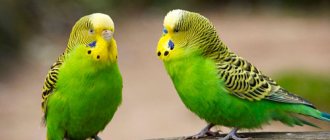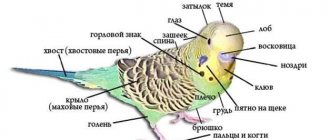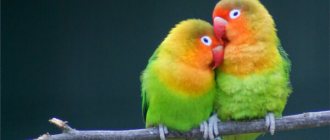Bright and colorful appearance, ability to copy and imitate, high mental abilities - it is not surprising that parrots have gained such popularity. Today there are more than 300 varieties of these wonderful birds; the breeds that are considered the most capable and intelligent will be discussed in this article.
Parrots have been kept in captivity for a very long time; according to the research of historians, the ancient Indians were the first to teach these birds to speak, then the fashion for exotic birds came to Europe. Alexander the Great brought them to their homeland for the first time; from Greece they were brought to Rome and the New World. Because of their ability to reproduce sounds and human speech, birds were considered sacred. There were even specially trained parrots in the Vatican that spoke words in several languages, and an honorary position was even created - parrot keeper.
Currently, many people have such pets, but not everyone has the time and patience to train them to speak. It is easier to teach a chick to talk than an adult. When choosing a parrot, choose one that sits calmly in a cage and listens with interest to its speech; it will be much more problematic to train rushing and wild birds. Training should begin after the adaptation period has ended: choose a melodious name for your pet and repeat it often. Learning will go faster when the bird trusts you, sits on your shoulder, and eats from your hand. Training should be carried out by one person, avoid long words and complex phrases, and do not change intonation often. Focus on a calm tone and 2-3 phrases and speak them regularly with your parrot; at first, do not let your pet watch TV or listen to the radio.
What breeds of parrots are considered the smartest in terms of onomatopoeia and speech learning?
Jaco
Despite their unattractive gray coloration, these birds are distinguished by high mental abilities. Their homeland is West Africa; parrots live mainly in forests. Grays grow up to 35-42 cm. Grays quickly learn spoken language; well-trained pets have the intelligence of a three-year-old child; they imitate male and female voices, the sounds of nature, the roar of animals, and whistle melodies. American scientists have proven that gray parrots not only learn words and phrases, but are also capable of conducting a dialogue. The sex of the Gray does not matter much; both males and females train well.
Amazon
This species includes 25 species that live in South and Central America. They are considered one of the best imitators of speech; they have a higher ability to imitate than the Gray Gray, although they are somewhat inferior in intelligence. They are affectionate to humans, have a friendlier character, and tolerate captivity well. On average, they can learn 80-100 words and also speak in short sentences. Amazon parrots can also perform simple circus tricks, reproduce the tones of musical instruments, whistle melodies, imitate animals and the sounds of nature. These are one of the few parrots that do not hesitate to speak in the presence of a person and love attention to themselves. The best options for keeping in captivity are white-headed, yellow-winged, blue- and red-fronted, Brazilian and Venezuelan Amazons.
Cockatoo
Cheerful and cheerful parrots, whose natural habitat is Indonesia, the Philippine Islands, Australia, and New Guinea. The size of the birds is impressive: from 30 to 70 cm, there are also many color variations. They have real artistic talent: they love to fluff up their crest, dance, and their powerful beak becomes a real tool with which parrots gnaw through bars and open locks. As for speech abilities, cockatoos are somewhat inferior to their two brothers described above, but in imitation they have no equal. Pink cockatoos and Inca cockatoos are the best to train. Cockatoos remember several dozen words and simple phrases, but they reproduce the most bizarre sounds and melodies.
What is needed to keep large parrots in the house
Cage for a parrot
Parrot cage option
When choosing a cage for a large parrot, you should definitely take into account the size of its body. So, for example, the largest parrots are considered to be Cockatoos and Macaws. Their body length can be 70-100 centimeters. For example, the average size of a male Macaw is 72-98 centimeters, and a Cockatoo is up to 60 centimeters.
Be sure to take into account the wingspan of your feathered pet - after all, having such an impressive size, large parrots are quite strong. And, weak metal rods or mesh may simply not withstand their onslaught. Therefore, if you decide to keep a large parrot in a cage (although experts still recommend keeping it in an aviary), make sure that its mesh is thick enough and strong, at least 4 millimeters in diameter with the thickness of the rods.
Recommended cage sizes for Cockatoos or Macaws: 100 centimeters by 100 centimeters and 170 centimeters.
If you do not have the opportunity to equip an aviary for the bird, you can simply fence off part of the room for keeping it and arrange an indoor aviary.
Jaco and Amazon are somewhat smaller in size, so the average size of Amazon is 25-45 centimeters, and Jaco is 30-40 centimeters. Recommended cage dimensions for them: 65 centimeters by 50 centimeters by 80 centimeters.
Mandatory cage requirements for large parrots
In addition to its large size (the larger the better), the cage must be made of solid metal and preferably stainless steel, its rods must be unpainted and not galvanized, it must have a retractable tray to facilitate cleaning, and there must be no wood inside the parrot’s home elements. It is best to lock such a cage with a secure padlock, since large parrots have innate high intelligence and can easily unlock the lock and escape into freedom.
Parrot accessories
In addition to accessories for arranging the cage, you will also need a deep bird net - with its help, especially at first, you will catch the parrot. This is much more convenient and safer, and the risk that you will inadvertently damage or injure your feathered pet is minimal. Yes, and the parrot will not be offended by you, but by the net.
Another necessary accessory is a taming stick - a flexible plastic stick, 100-120 centimeters long, with a small metal fork at the end. With its help, you will treat your pet with treats, and by gradually shortening its length, you will at the same time tame the pet to your hands; in the end, he will get used to you and will take food from your hands without fear.
You will also need a small flashlight with a non-scattering light - you will use it to attract the bird's attention and leather gloves - they will protect your hands from being bitten at first.
Macaw
It is considered one of the largest and at the same time gifted parrots, although it does not remember many words - about 20, but pronounces them meaningfully and always to the point. However, there are individuals who quite successfully operate with 100 words and sentences. This order includes 15 species, their life expectancy is 80-100 years. If the owner treats the pet well, he will repay him with love, if the macaw is offended, he becomes aggressive. The macaw's voice is shrill and cutting to the ear, so not everyone will choose it as a poultry. The most popular are blue-yellow, green-winged, hyacinth and red macaws - they perfectly imitate sounds (a dog barking, a door creaking, etc.) and voices, and whistle melodies.
Feeding large parrots
A large parrot should be fed at least 2 times a day
When compiling a bird’s diet, of course, it is necessary to take into account its size. Large parrots eat more than budgies, and you should be prepared for this. Otherwise, there is nothing special on their menu. These are grain mixtures, sprouted grains, seeds and nuts, raw vegetables and fruits, fermented milk products, cereals, tree branches, mineral supplements and gastroliths. Also, the parrot should always have fresh water in its drinking bowl.
What not to give to large parrots
If you want your bird not to get sick, you should not give it oak branches, pear branches, coniferous trees, wild garlic and poplar branches. It is worth giving up persimmons, avocados, mangoes, papaya, potatoes, parsley and other spicy plants; candied fruits and sweets, salty foods, and dishes from your table should be prohibited. There is also a clear veterinary prohibition regarding meat, butter, cheese, fish and seafood.
Approximate daily diet of a parrot
If you have a parrot the size of a Jaco, during the day he should eat 2 tablespoons of a grain mixture, 2 tablespoons of sprouted grains, ½ apple or orange, ½ sweet pepper, a slice of cucumber or tomatoes, 5-6 berries, 3-4 teaspoons spoons of kefir, 20 grams of cottage cheese (given once a week), and drink 5-6 teaspoons of freshly squeezed natural juice without sugar. Water and greens are given to the parrot in unlimited quantities.
Budgerigar
An interesting feature of this species is that it is mostly males who talk, while females prefer to remain silent. Budgerigars cannot pronounce words clearly and loudly, they still resemble chirping, but the volume of their vocabulary is impressive - up to 150 words. Parrots remember the intonations of the human voice well, are able to imitate them, whistle melodies, and imitate the singing of birds. Sometimes female wavy birds enrich their vocabulary with several dozen words, but males are still preferable for training.
Corella
Bright and sociable parrots with a funny crest and gray-white plumage. If you compare a cockatiel with a budgie, the latter talk more, but cockatiels pronounce words more clearly. Representatives of this species have the ability to speak; they can learn to repeat words and sentences, imitate sounds, and whistle melodies. The voice of cockatiels is quite shrill and sharp; these parrots distort human speech and pronounce words with a characteristic chirp. Such pets cannot conduct a dialogue; they give out their entire supply, regardless of the situation.
Key points in keeping a parrot
Everyone who is about to become the owner of a parrot or is already one has to deal with the character of the bird. Therefore, you should immediately pay attention to what advantages and disadvantages of a feathered friend the whole family will have to live with.
So, we can highlight the following advantages of keeping a parrot:
- always a cheerful pet who will happily greet its owner every time;
- the parrot almost always takes care of its own appearance, so the owners can only rejoice and admire the appearance of the bird;
- large parrots, thanks to their intelligence, become objects of close observation, as well as possible mutual communication;
- unlike four-legged pets, keeping parrots does not have such a pronounced smell;
- Cleaning up after birds, subject to simple rules and tips, is quite simple;
- parrots do not need regular walking; but they will be pleased to be outside sometimes if you have such an opportunity)
- Following simple rules for keeping and feeding birds will allow them to live a long and healthy life.
But when getting a parrot, you should also remember some of the inconveniences that it can cause to others. For example:
- Parrots by nature have rather sharp and piercing screams, but they can also be annoying;
- the bird should be given a sufficient amount of time for communication, it is directly proportional to the intelligence of the parrot;
- parrots are also quite curious by nature, so it is better to keep all important documents or objects out of the bird’s reach;
- family members may be allergic to feathers and down, as well as animal fur;
- You need to remember that a large parrot is capable of biting quite painfully.
However, it is obvious that there are more advantages, and they are much more pleasant. Therefore, before getting a parrot, it is necessary to study as much information as possible regarding its behavior at home. After all, the rules for its maintenance and care are not the least important in choosing a species. Only after this is it better to decide on a pet. Be that as it may, having a parrot will make you much happier. After all, such a direct pet and friend will delight its owner throughout his life.
Rosella
A fairly popular variety of parrots, they easily adapt to new conditions and are undemanding in their maintenance. Their speaking abilities are weak; pets remember no more than 10 words, most often limiting themselves to 2-5 words. Rosellas have beautiful singing, they are able to imitate the voices of other birds, the sounds of nature, most often they remember their name or the name of the owner and pronounce it. Rosellas are quite aggressive towards other birds, so it is better to keep them only with fellow birds. The most popular are pale-headed, chick-cheeked, variegated, black-headed, and yellow-bellied rosellas.
By the way, the smartest parrot, listed in the Guinness Book of Records, was a gray parrot. His name was Alex and he lived for 31 years. Jaco knew more than 400 words in different languages, knew how to correctly construct sentences, and had the ability to sing and musical memory. Alex was trained by Irene Pepperberg from Arizona. Alex distinguished geometric shapes, colors, the number of objects, and could read syllables. His level of intelligence corresponded to the development of a five-year-old child.
So, dear owners of smart and clever feathered creatures, be patient and attentive, and your pets will surprise you more than once!
Types of large parrots
First of all, let's decide what large parrots can be kept at home. So, these are Jaco, Amazon and Cockatoo... Moreover, each of them has its own temperament and character. And here are the recommendations on the peculiarities of their maintenance - in principle, general, with the exception of the characteristics of the diet, as well as the relationship of birds to water - some like to swim, while others - not so much. What’s interesting is that all these points in some respects differ significantly from the features of keeping small budgies at home (read more about the features of keeping them, as well as about the types of parrots). Moreover, according to experts, it is large parrots that learn to speak the fastest, are well tamed, and in their person you can find not just a pet that you have to take care of, but an equal member of the family who can be interesting interlocutors.
And now more about the types of large parrots...
Gray or Gray parrots
Parrot Jaco
These birds quickly become attached to their owner and consider him similar to themselves. However, it is worth knowing that they are very vulnerable and touchy, and if you suddenly inadvertently hurt their feelings, you will have to ask for forgiveness and make amends for a long time.
Amazon
Parrot Amazon
This type of large parrots is more receptive to new information, they learn to speak faster, their intelligence is well developed, they quickly adapt to changes in the environment around them, they are well tamed and have an affectionate character. They can become a good friend for a teenage child.
Cockatoo
Parrot Cockatoo
Very sociable and nimble birds, they are curious, love to be the center of attention, and do not tolerate loneliness and the absence of their owner. Therefore, if you do not want your feathered pet to get bored in your absence, make sure to provide him with the right amount of toys with which he can have fun while you are working or away. By the way, precisely because these birds are very affectionate and have a hard time being separated from their owner, it is recommended that several family members look after them at once. Then, the absence of the main owner will not be so painful for the parrot, and he will not miss and yearn for him.
